Response of Soil Microbial Communities to Elevation Gradient in Central Subtropical Pinus taiwanensis and Pinus massoniana Forests
Abstract
1. Introduction
2. Materials and Methods
2.1. Study Area
2.2. Experimental Design and Soil Sampling
2.3. Soil Properties Analysis
2.4. Extraction, Amplification and Sequencing of DNA
2.5. Statistical Analyses
3. Results
3.1. Soil Properties along the Elevation Gradient
3.2. Analysis of Soil Microbial Diversity
3.3. Analysis of Soil Microbial Community Composition
3.4. Distribution of Major Phyla of Soil Microbial Communities
3.5. The Association between Soil Properties and Microbial Communities
4. Discussion
4.1. Effect of Elevation Gradient on Soil Properties in Different Pine Forests
4.2. Response Characteristics of Soil Microbial Communities to Elevation Gradient in Different Pine Forests
4.3. Driving Factors of Soil Microbial Community Changes in Different Pine Forests
5. Conclusions
Author Contributions
Funding
Institutional Review Board Statement
Informed Consent Statement
Data Availability Statement
Conflicts of Interest
Appendix A
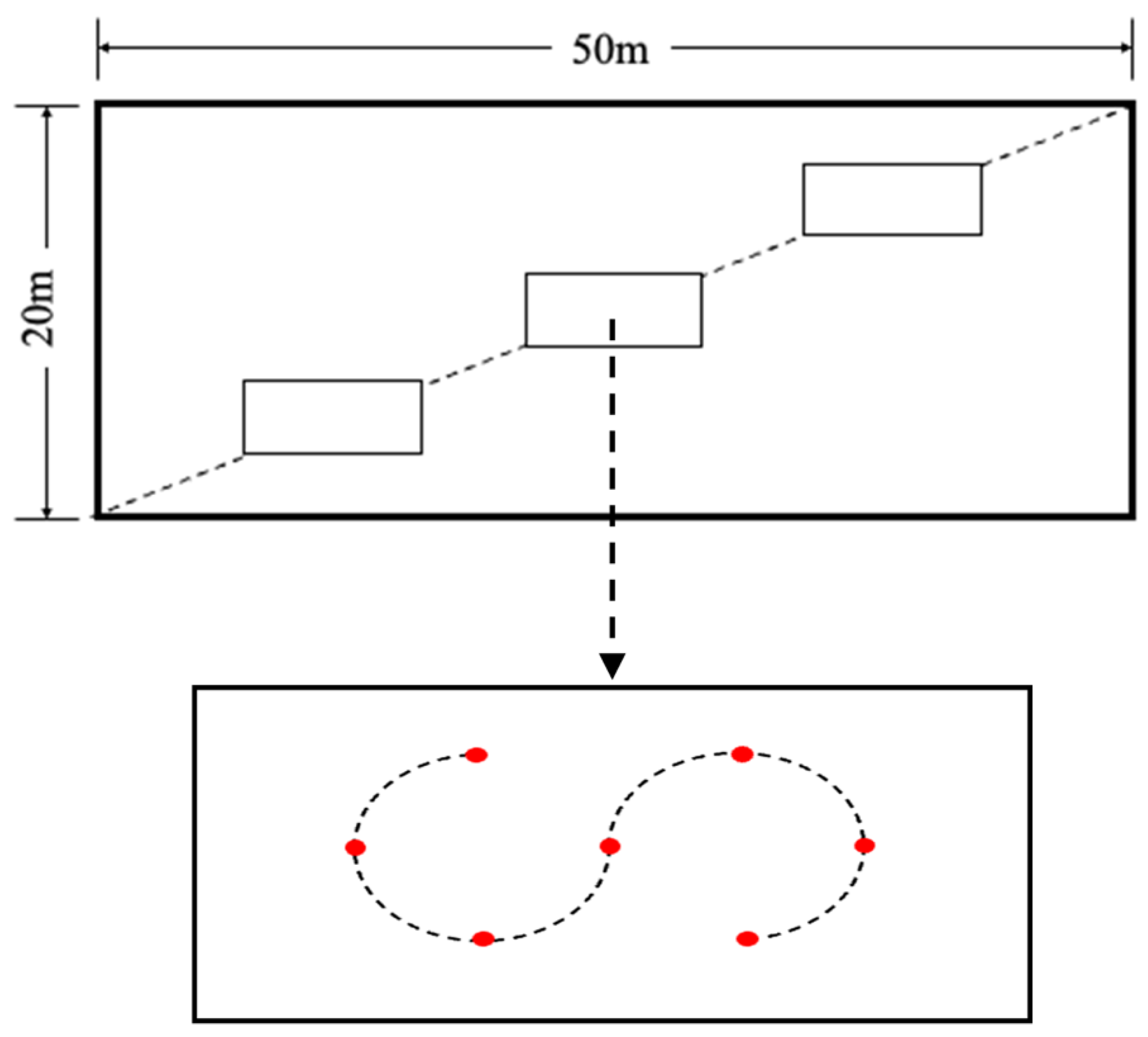
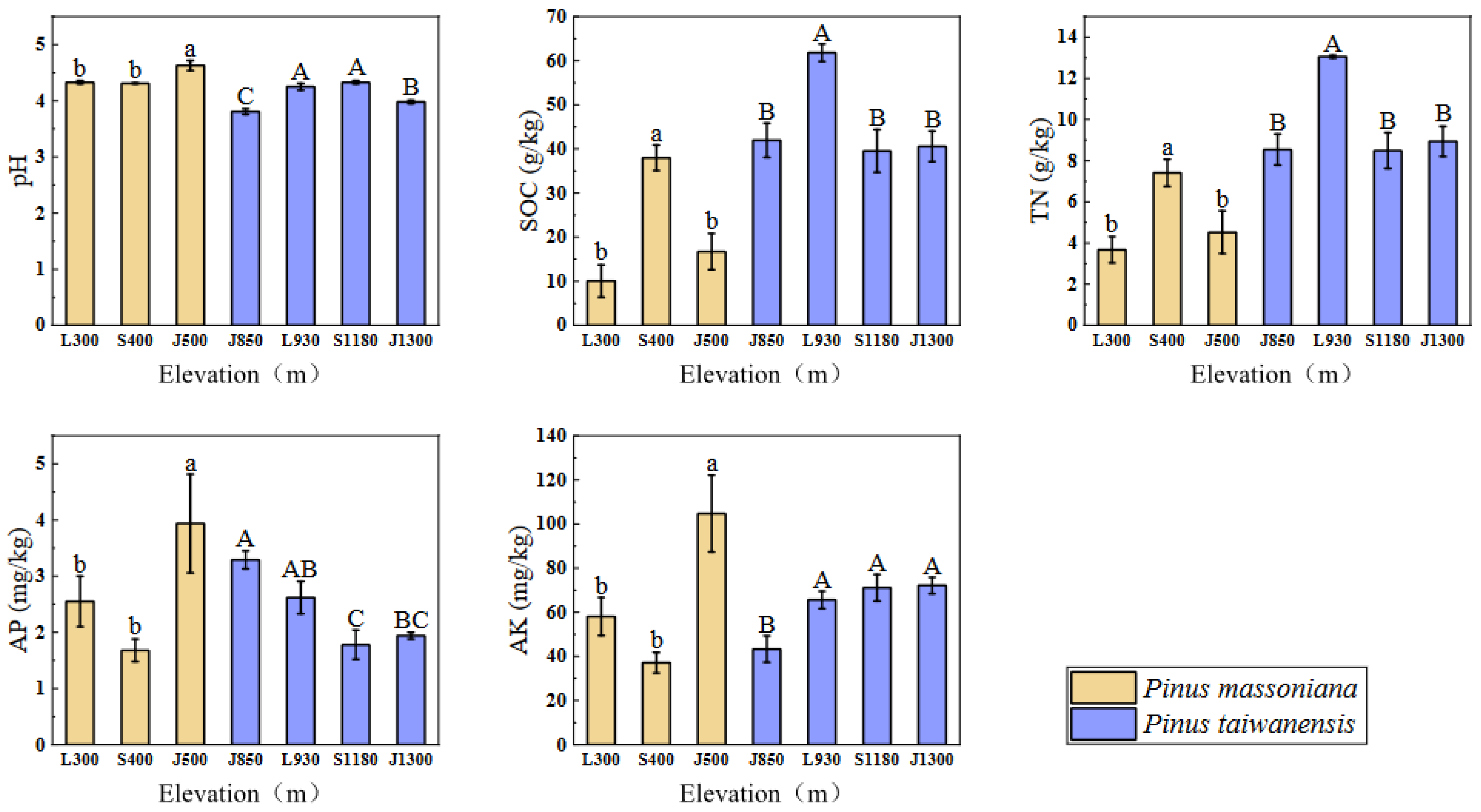
| Vegetation | Elevation (m) | Sobs | Chao1 | Shannon | Simpson (10−2) |
|---|---|---|---|---|---|
| Pinus taiwanensis | J1300 | 2306 ± 71.47 b | 2554.55 ± 76.16 b | 8.62 ± 0.08 ab | 99.25 ± 0.05 a |
| S1180 | 2648.33 ± 73.93 a | 2926.19 ± 70.7 a | 8.79 ± 0.06 a | 99.33 ± 0.05 a | |
| L930 | 2453.67 ± 65.69 ab | 2687.35 ± 41.28 ab | 8.54 ± 0.14 ab | 99.01 ± 0.24 a | |
| J850 | 2324.67 ± 139.87 b | 2550.47 ± 121.2 b | 8.33 ± 0.14 b | 99.05 ± 0.12 a | |
| Pinus massoniana | J500 | 3160 ± 40 a | 3307.43 ± 45.61 a | 9.05 ± 0.11 a | 99.32 ± 0.12 a |
| S400 | 2486.67 ± 133.96 b | 2741.61 ± 115.76 b | 8.69 ± 0.13 b | 99.17 ± 0.15 a | |
| L300 | 2496.67 ± 34.27 b | 2726.66 ± 35.84 b | 8.76 ± 0.02 ab | 99.25 ± 0.15 a |
| Vegetation | Elevation (m) | Sobs | Chao1 | Shannon | Simpson (10−2) |
|---|---|---|---|---|---|
| Pinus taiwanensis | J1300 | 1372 ± 10.79 a | 1694.52 ± 34.24 a | 6.02 ± 0.45 a | 92.03 ± 4.84 a |
| S1180 | 1386 ± 54.68 a | 1702.34 ± 32.13 a | 5.96 ± 0.63 a | 92.7 ± 3.92 a | |
| L930 | 1448.67 ± 30.6 a | 1760.94 ± 69.23 a | 6.21 ± 0.18 a | 96.03 ± 0.65 a | |
| J850 | 1150.67 ± 45.74 b | 1391.58 ± 36.66 b | 6.25 ± 0.26 a | 96.71 ± 0.53 a | |
| Pinus massoniana | J500 | 1057.67 ± 15.32 b | 1268.47 ± 24.26 b | 5.77 ± 0.44 a | 92.6 ± 3.21 a |
| S400 | 1225.67 ± 42.21 a | 1503.58 ± 59.46 a | 6.06 ± 0.15 a | 94.7 ± 1.38 a | |
| L300 | 1238.33 ± 41.57 a | 1558.44 ± 25.47 a | 6.21 ± 0.27 a | 95.01 ± 0.56 a |
References
- Cui, Y.; Fang, L.; Guo, X.; Wang, X.; Wang, Y.; Li, P.; Zhang, Y.; Zhang, X. Responses of soil microbial communities to nutrient limitation in the desert-grassland ecological transition zone. Sci. Total. Environ. 2018, 642, 45–55. [Google Scholar] [CrossRef] [PubMed]
- Körner, C. The use of ‘altitude’in ecological research. Trends Ecol. Evol. 2007, 22, 569–574. [Google Scholar] [CrossRef]
- De Wit, R.; Bouvier, T. ‘Everything is everywhere, but, the environment selects’; what did Baas Becking and Beijerinck really say? Environ. Microbiol. 2006, 8, 755–758. [Google Scholar] [CrossRef] [PubMed]
- Liu, D.; Wang, H.; An, S.; Bhople, P.; Davlatbekov, F. Geographic distance and soil microbial biomass carbon drive biogeographical distribution of fungal communities in Chinese Loess Plateau soils. Sci. Total. Environ. 2019, 660, 1058–1069. [Google Scholar] [CrossRef] [PubMed]
- Singh, D.; Takahashi, K.; Kim, M.; Chun, J.; Adams, J.M. A Hump-Backed Trend in Bacterial Diversity with Elevation on Mount Fuji, Japan. Microb. Ecol. 2011, 63, 429–437. [Google Scholar] [CrossRef]
- Nottingham, A.T.; Fierer, N.; Turner, B.; Whitaker, J.; Ostle, N.; McNamara, N.P.; Bardgett, R.D.; Leff, J.W.; Salinas, N.; Silman, M.R.; et al. Microbes follow Humboldt: Temperature drives plant and soil microbial diversity patterns from the Amazon to the Andes. Ecology 2018, 99, 2455–2466. [Google Scholar] [CrossRef]
- Shen, C.; Xiong, J.; Zhang, H.; Feng, Y.; Lin, X.; Li, X.; Liang, W.; Chu, H. Soil pH drives the spatial distribution of bacterial communities along elevation on Changbai Mountain. Soil Biol. Biochem. 2013, 57, 204–211. [Google Scholar] [CrossRef]
- Ren, C.; Zhang, W.; Zhong, Z.; Han, X.; Yang, G.; Feng, Y.; Ren, G. Differential responses of soil microbial biomass, diversity, and compositions to altitudinal gradients depend on plant and soil characteristics. Sci. Total Environ. 2018, 610–611, 750–758. [Google Scholar] [CrossRef] [PubMed]
- Shen, C.; Liang, W.; Shi, Y.; Lin, X.; Zhang, H.; Wu, X.; Xie, G.; Chain, P.; Grogan, P.; Chu, H. Contrasting elevational diversity patterns between eukaryotic soil microbes and plants. Ecology 2014, 95, 3190–3202. [Google Scholar] [CrossRef]
- Yang, Y.; Zhou, Y.; Shi, Z.; Rossel, R.A.V.; Liang, Z.; Wang, H.; Zhou, L.; Yu, W. Interactive effects of elevation and land use on soil bacterial communities in the Tibetan Plateau. Pedosphere 2020, 30, 817–831. [Google Scholar] [CrossRef]
- Shen, C.C.; Ni, Y.Y.; Liang, W.J.; Wang, J.J.; Chu, H.Y. Distinct soil bacterial communities along a small-scale elevational gradient in alpine tundra. Front. Microbiol. 2015, 6, 582. [Google Scholar]
- Yao, Q.; Li, Z.; Song, Y.; Wright, S.J.; Guo, X.; Tringe, S.G.; Tfaily, M.M.; Paša-Tolić, L.; Hazen, T.C.; Turner, B.L.; et al. Community proteogenomics reveals the systemic impact of phosphorus availability on microbial functions in tropical soil. Nat. Ecol. Evol. 2018, 2, 499–509. [Google Scholar] [CrossRef] [PubMed]
- Trivedi, P.; Leach, J.E.; Tringe, S.G.; Sa, T.; Singh, B.K. Plant–microbiome interactions: From community assembly to plant health. Nat. Rev. Microbiol. 2020, 18, 607–621. [Google Scholar] [CrossRef] [PubMed]
- Chong, C.W.; Pearce, D.A.; Convey, P.; Tan, G.A.; Wong, R.C.; Tan, I.K. High levels of spatial heterogeneity in the biodiversity of soil prokaryotes on Signy Island, Antarctica. Soil Biol. Biochem. 2010, 42, 601–610. [Google Scholar] [CrossRef]
- Chu, H.; Neufeld, J.D.; Walker, V.K.; Grogan, P. The Influence of Vegetation Type on the Dominant Soil Bacteria, Archaea, and Fungi in a Low Arctic Tundra Landscape. Soil Sci. Soc. Am. J. 2011, 75, 1756–1765. [Google Scholar] [CrossRef]
- Xiao, L.; Liu, G.-B.; Xue, S. Effects of vegetational type and soil depth on soil microbial communities on the Loess Plateau of China. Arch. Agron. Soil Sci. 2016, 62, 1665–1677. [Google Scholar] [CrossRef]
- Kui, L.; Xiang, G.; Wang, Y.; Wang, Z.; Li, G.; Li, D.; Yan, J.; Ye, S.; Wang, C.; Yang, L. Large-Scale Characterization of the Soil Microbiome in Ancient Tea Plantations Using High-Throughput 16S rRNA and Internal Transcribed Spacer Amplicon Sequencing. Front. Microbiol. 2021, 12, 745225. [Google Scholar] [CrossRef]
- Zhao, Y.; Zhou, Y.; Jia, X.; Han, L.; Liu, L.; Ren, K.; Ye, X.; Qu, Z.; Pei, Y. Soil characteristics and microbial community structure on along elevation gradient in a Pinus armandii forest of the Qinling Mountains, China. For. Ecol. Manag. 2021, 503, 119793. [Google Scholar] [CrossRef]
- Yao, X.; Yu, K.; Deng, Y.; Zeng, Q.; Lai, Z.; Liu, J. Spatial distribution of soil organic carbon stocks in Masson pine (Pinus massoniana) forests in subtropical China. Catena 2019, 178, 189–198. [Google Scholar] [CrossRef]
- Chen, D.; Fang, K.; Li, Y.; Dong, Z.; Zhang, Y.; Zhou, F. Response of Pinus taiwanensis growth to climate changes at its southern limit of Daiyun Mountain, mainland China Fujian Province. Sci. China Earth Sci. 2015, 59, 328–336. [Google Scholar] [CrossRef]
- Shi, X.; Yu, D.; Xu, S.; Warner, E.; Wang, H.; Sun, W.; Zhao, Y.; Gong, Z. Cross-reference for relating Genetic Soil Classification of China with WRB at different scales. Geoderma 2010, 155, 344–350. [Google Scholar] [CrossRef]
- People’s Government of Jiangxi Province; Provincial Department of Water Resources of Jiangxi. Jiangxi Soil and Water Conservation Plan (2016–2030). 2016. Available online: http://www.jiangxi.gov.cn/col/col472/index.html (accessed on 1 October 2022).
- Zhang, C.; Deng, Q.; Liu, A.; Liu, C.; Xie, G. Effects of Stand Structure and Topography on Forest Vegetation Carbon Density in Jiangxi Province. Forests 2021, 12, 1483. [Google Scholar] [CrossRef]
- Bangroo, S.; Najar, G.; Rasool, A. Effect of altitude and aspect on soil organic carbon and nitrogen stocks in the Himalayan Mawer Forest Range. Catena 2017, 158, 63–68. [Google Scholar] [CrossRef]
- Hu, L.; Xiang, Z.; Wang, G.; Rafique, R.; Liu, W.; Wang, C. Changes in soil physicochemical and microbial properties along elevation gradients in two forest soils. Scand. J. For. Res. 2015, 31, 242–253. [Google Scholar] [CrossRef]
- Guo, M.; Wu, F.; Hao, G.; Qi, Q.; Li, R.; Li, N.; Wei, L.; Chai, T. Bacillus subtilis Improves Immunity and Disease Resistance in Rabbits. Front. Immunol. 2017, 8, 354. [Google Scholar] [CrossRef]
- Toju, H.; Tanabe, A.; Yamamoto, S.; Sato, H. High-Coverage ITS Primers for the DNA-Based Identification of Ascomycetes and Basidiomycetes in Environmental Samples. PLoS ONE 2012, 7, e40863. [Google Scholar] [CrossRef]
- Caporaso, J.G.; Lauber, C.L.; Walters, W.A.; Berg-Lyons, D.; Huntley, J.; Fierer, N.; Owens, S.M.; Betley, J.; Fraser, L.; Bauer, M.; et al. Ultra-high-throughput microbial community analysis on the Illumina HiSeq and MiSeq platforms. ISME J. 2012, 6, 1621–1624. [Google Scholar] [CrossRef] [PubMed]
- Chen, S.; Zhou, Y.; Chen, Y.; Gu, J. fastp: An ultra-fast all-in-one FASTQ preprocessor. Bioinformatics 2018, 34, i884–i890. [Google Scholar] [CrossRef]
- Edgar, R.C. UPARSE: Highly accurate OTU sequences from microbial amplicon reads. Nat. Methods 2013, 10, 996–998. [Google Scholar] [CrossRef]
- Wang, Q.; Garrity, G.M.; Tiedje, J.M.; Cole, J.R. Naive Bayesian classifier for rapid assignment of rRNA sequences into the new bacterial taxonomy. Appl. Environ. Microbiol. 2007, 73, 5261–5267. [Google Scholar] [CrossRef]
- Pruesse, E.; Quast, C.; Knittel, K.; Fuchs, B.M.; Ludwig, W.; Peplies, J.; Glöckner, F.O. SILVA: A comprehensive online resource for quality checked and aligned ribosomal RNA sequence data compatible with ARB. Nucleic Acids Res. 2007, 35, 7188–7196. [Google Scholar] [CrossRef]
- Ankenbrand, M.J.; Keller, A.; Wolf, M.; Schultz, J.; Foerster, F. ITS2 Database V: Twice as Much. Mol. Biol. Evol. 2015, 32, 3030–3032. [Google Scholar] [CrossRef]
- Caporaso, J.G.; Kuczynski, J.; Stombaugh, J.; Bittinger, K.; Bushman, F.D.; Costello, E.K.; Fierer, N.; Gonzalez Peña, A.; Goodrich, J.K.; Gordon, J.I.; et al. QIIME allows analysis of high-throughput community sequencing data. Nat. Methods 2010, 7, 335–336. [Google Scholar] [CrossRef]
- Wickham, H. ggplot2. Wiley Interdiscip. Rev. Comput. Stat. 2011, 3, 180–185. [Google Scholar] [CrossRef]
- Edgar, R.C. MUSCLE: Multiple sequence alignment with high accuracy and high throughput. Nucleic Acids Res. 2004, 32, 1792–1797. [Google Scholar] [CrossRef]
- Price, M.N.; Dehal, P.S.; Arkin, A.P. FastTree 2—Approximately Maximum-Likelihood Trees for Large Alignments. PLoS ONE 2010, 5, e9490. [Google Scholar] [CrossRef] [PubMed]
- Oksanen, J. Vegan: Community Ecology Package. 2010. Available online: http://cran.R-project.org/package=vegan (accessed on 1 October 2022).
- Thirumalai, C.; Chandhini, S.A.; Vaishnavi, M. Analysing the concrete compressive strength using Pearson and Spearman. In Proceedings of the 2017 International Conference of Electronics, Communication and Aerospace Technology, Coimbatore, India, 20–22 April 2017; pp. 215–218. [Google Scholar] [CrossRef]
- Revelle, W. Psych: Procedures for Personality and Psychological Research. 2015. Available online: http://CRAN.R-project.org/package=psych (accessed on 1 October 2022).
- Gronau, I.; Moran, S. Optimal implementations of UPGMA and other common clustering algorithms. Inf. Process. Lett. 2007, 104, 205–210. [Google Scholar] [CrossRef]
- Yu, F.; Zhang, Z.; Chen, L.; Wang, J.; Shen, Z. Spatial distribution characteristics of soil organic carbon in subtropical forests of mountain Lushan, China. Environ. Monit. Assess. 2018, 190, 545. [Google Scholar] [CrossRef] [PubMed]
- Müller, M.; Oelmann, Y.; Schickhoff, U.; Böhner, J.; Scholten, T. Himalayan treeline soil and foliar C:N:P stoichiometry indicate nutrient shortage with elevation. Geoderma 2017, 291, 21–32. [Google Scholar] [CrossRef]
- Berger, T.W.; Duboc, O.; Djukic, I.; Tatzber, M.; Gerzabek, M.H.; Zehetner, F. Decomposition of beech (Fagus sylvatica) and pine (Pinus nigra) litter along an Alpine elevation gradient: Decay and nutrient release. Geoderma 2015, 251–252, 92–104. [Google Scholar] [CrossRef]
- Jiang, L.; He, Z.; Liu, J.; Xing, C.; Gu, X.; Wei, C.; Zhu, J.; Wang, X. Elevation Gradient Altered Soil C, N, and P Stoichiometry of Pinus taiwanensis Forest on Daiyun Mountain. Forests 2019, 10, 1089. [Google Scholar] [CrossRef]
- Shao, G.; Ai, J.; Sun, Q.; Hou, L.; Dong, Y. Soil quality assessment under different forest types in the Mount Tai, central Eastern China. Ecol. Indic. 2020, 115, 106439. [Google Scholar] [CrossRef]
- Ren, C.; Zhao, F.; Kang, D.; Yang, G.; Han, X.; Tong, X.; Feng, Y.; Ren, G. Linkages of C:N:P stoichiometry and bacterial community in soil following afforestation of former farmland. For. Ecol. Manag. 2016, 376, 59–66. [Google Scholar] [CrossRef]
- Margesin, R.; Jud, M.; Tscherko, D.; Schinner, F. Microbial communities and activities in alpine and subalpine soils. FEMS Microbiol. Ecol. 2009, 67, 208–218. [Google Scholar] [CrossRef] [PubMed]
- Siles, J.A.; Cajthaml, T.; Minerbi, S.; Margesin, R. Effect of altitude and season on microbial activity, abundance and community structure in Alpine forest soils. FEMS Microbiol. Ecol. 2016, 92, fiw008. [Google Scholar] [CrossRef] [PubMed]
- Weng, X.-H.; Sui, X.; Li, M.-S.; Liu, Y.-N.; Zhang, R.-T.; Yang, L.-B. Effects of Simulated Nitrogen Deposition on Soil Microbial Carbon Metabolism in Calamagrostis angustifolia Wetland in Sanjiang Plain. Huan Jing Ke Xue = Huanjing Kexue 2022, 43, 4674–4683. [Google Scholar] [PubMed]
- Meng, H.; Li, K.; Nie, M.; Wan, J.-R.; Quan, Z.-X.; Fang, C.-M.; Chen, J.-K.; Gu, J.-D.; Li, B. Responses of bacterial and fungal communities to an elevation gradient in a subtropical montane forest of China. Appl. Microbiol. Biotechnol. 2012, 97, 2219–2230. [Google Scholar] [CrossRef]
- Gomoryova, E.; Strelcova, K.; Fleischer, P.; Gomory, D. Soil microbial characteristics at the monitoring plots on wind-throw areas of the Tatra National Park (Slovakia): Their assessment as environmental indicators. Environ. Monit. Assess. 2011, 174, 31–45. [Google Scholar] [CrossRef]
- Hamer, U.; Makeschin, F.; An, S.; Zheng, F. Microbial activity and community structure in degraded soils on the Loess Plateau of China. J. Plant Nutr. Soil Sci. 2009, 172, 118–126. [Google Scholar] [CrossRef]
- Yang, Y.; Chai, Y.; Xie, H.; Zhang, L.; Zhang, Z.; Yang, X.; Hao, S.; Gai, J.; Chen, Y. Responses of soil microbial diversity, network complexity and multifunctionality to three land-use changes. Sci. Total. Environ. 2023, 859, 160255. [Google Scholar] [CrossRef]
- Wang, J.-T.; Cao, P.; Hu, H.-W.; Li, J.; Han, L.-L.; Zhang, L.-M.; Zheng, Y.-M.; He, J.-Z. Altitudinal Distribution Patterns of Soil Bacterial and Archaeal Communities Along Mt. Shegyla on the Tibetan Plateau. Microb. Ecol. 2014, 69, 135–145. [Google Scholar] [CrossRef]
- Schlatter, D.C.; Bakker, M.; Bradeen, J.; Kinkel, L.L. Plant community richness and microbial interactions structure bacterial communities in soil. Ecology 2015, 96, 134–142. [Google Scholar] [CrossRef]
- Kielak, A.M.; Barreto, C.C.; Kowalchuk, G.A.; Van Veen, J.A.; Kuramae, E.E. The Ecology of Acidobacteria: Moving beyond Genes and Genomes. Front. Microbiol. 2016, 7, 744. [Google Scholar] [CrossRef] [PubMed]
- Lv, X.; Yu, J.; Fu, Y.; Ma, B.; Qu, F.; Ning, K.; Wu, H. A Meta-Analysis of the Bacterial and Archaeal Diversity Observed in Wetland Soils. Sci. World J. 2014, 2014, 437684. [Google Scholar] [CrossRef]
- Zeng, Q.; Jia, P.; Wang, Y.; Wang, H.; Li, C.; An, S. The local environment regulates biogeographic patterns of soil fungal communities on the Loess Plateau. Catena 2019, 183, 104220. [Google Scholar] [CrossRef]
- Tedersoo, L.; Bahram, M.; Põlme, S.; Kõljalg, U.; Yorou, N.S.; Wijesundera, R.; Ruiz, L.V.; Vasco-Palacios, A.M.; Thu, P.Q.; Suija, A.; et al. Global diversity and geography of soil fungi. Science 2014, 346, 1256688. [Google Scholar] [CrossRef] [PubMed]
- Thomson, B.C.; Tisserant, E.; Plassart, P.; Uroz, S.; Griffiths, R.I.; Hannula, S.E.; Buee, M.; Mougel, C.; Ranjard, L.; Van Veen, J.A.; et al. Lemanceau, Soil conditions and land use intensification effects on soil microbial communities across a range of European field sites. Soil Biol. Biochem. 2015, 88, 403–413. [Google Scholar] [CrossRef]
- Urbanová, M.; Šnajdr, J.; Baldrian, P. Composition of fungal and bacterial communities in forest litter and soil is largely determined by dominant trees. Soil Biol. Biochem. 2015, 84, 53–64. [Google Scholar] [CrossRef]
- Bahram, M.; Põlme, S.; Kõljalg, U.; Zarre, S.; Tedersoo, L. Regional and local patterns of ectomycorrhizal fungal diversity and community structure along an altitudinal gradient in the Hyrcanian forests of northern Iran. N. Phytol. 2011, 193, 465–473. [Google Scholar] [CrossRef]
- Donhauser, J.; Niklaus, P.A.; Rousk, J.; Larose, C.; Frey, B. Temperatures beyond the community optimum promote the dominance of heat-adapted, fast growing and stress resistant bacteria in alpine soils. Soil Biol. Biochem. 2020, 148, 107873. [Google Scholar] [CrossRef]
- Guadarrama, P.; Castillo, S.; Ramos-Zapata, J.A.; Hernandez-Cuevas, L.V.; Camargo-Ricalde, S.L. Arbuscular my-cor-rhizal fungal communities in changing environments: The effects of seasonality and anthropogenic disturbance in a seasonal dry fores. Pedobiologia 2014, 57, 87–95. [Google Scholar] [CrossRef]
- Zimmermann, M.; Leifeld, J.; Conen, F.; Bird, M.; Meir, P. Can composition and physical protection of soil organic matter explain soil respiration temperature sensitivity? Biogeochemistry 2010, 107, 423–436. [Google Scholar] [CrossRef]
- Ding, L.; Shang, Y.; Zhang, W.; Zhang, Y.; Li, S.; Wei, X.; Zhang, Y.; Song, X.; Chen, X.; Liu, J.; et al. Disentangling the effects of driving forces on soil bacterial and fungal communities under shrub encroachment on the Guizhou Plateau of China. Sci. Total. Environ. 2019, 709, 136207. [Google Scholar] [CrossRef] [PubMed]
- Pei, Z.; Eichenberg, D.; Bruelheide, H.; Kröber, W.; Kühn, P.; Li, Y.; von Oheimb, G.; Purschke, O.; Scholten, T.; Buscot, F.; et al. Soil and tree species traits both shape soil microbial communities during early growth of Chinese subtropical forests. Soil Biol. Biochem. 2016, 96, 180–190. [Google Scholar] [CrossRef]
- Zhao, R.; Yang, X.; Tian, Q.; Wang, X.; Liao, C.; Li, C.-L.; Liu, F. Soil microbial community structure, metabolic potentials and influencing factors in a subtropical mountain forest ecosystem of China. Environ. Pollut. Bioavailab. 2020, 32, 69–78. [Google Scholar] [CrossRef]
- Zhang, B.; Xue, K.; Zhou, S.; Che, R.; Du, J.; Tang, L.; Pang, Z.; Wang, F.; Wang, D.; Cui, X.; et al. Phosphorus mediates soil prokaryote distribution pattern along a small-scale elevation gradient in Noijin Kangsang Peak, Tibetan Plateau. FEMS Microbiol. Ecol. 2019, 95, fiz076. [Google Scholar] [CrossRef]
- Fu, D.; Wu, X.; Duan, C.; Smith, A.R.; Jones, D.L. Traits of dominant species and soil properties co-regulate soil mi-crobial communities across land restoration types in a subtropical plateau region of Southwest China. Ecol. Eng. 2020, 153, 105897. [Google Scholar] [CrossRef]

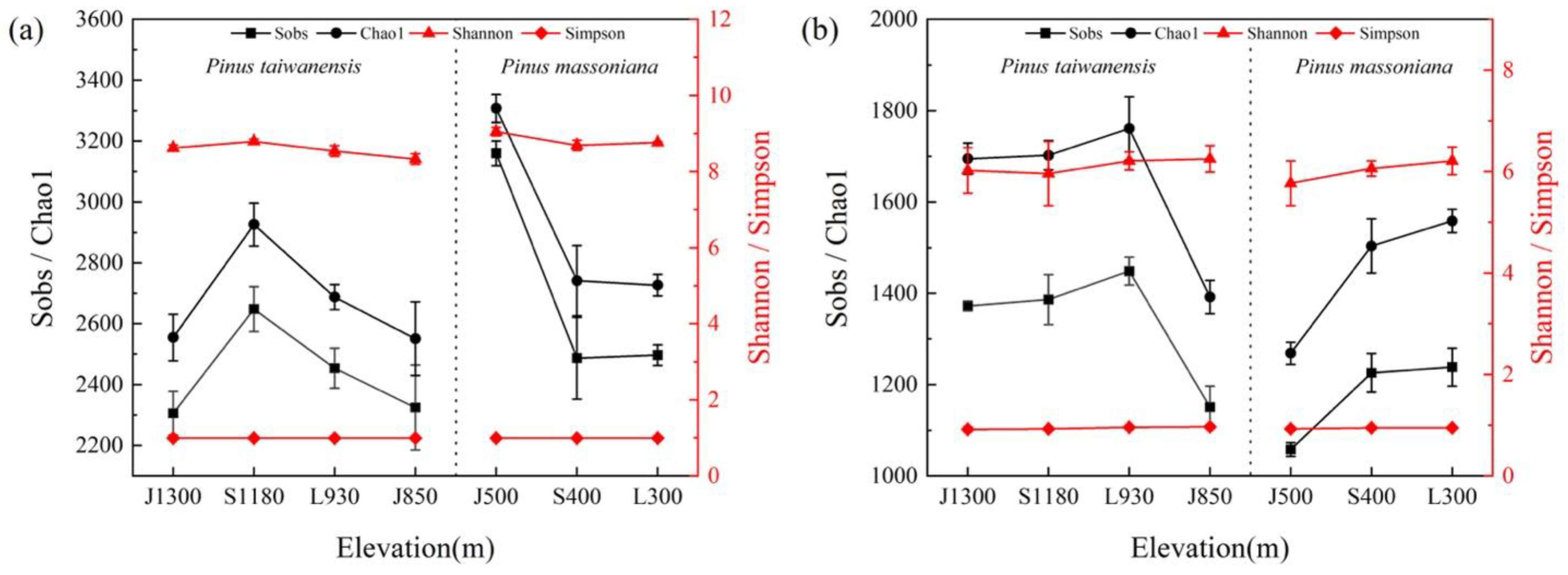
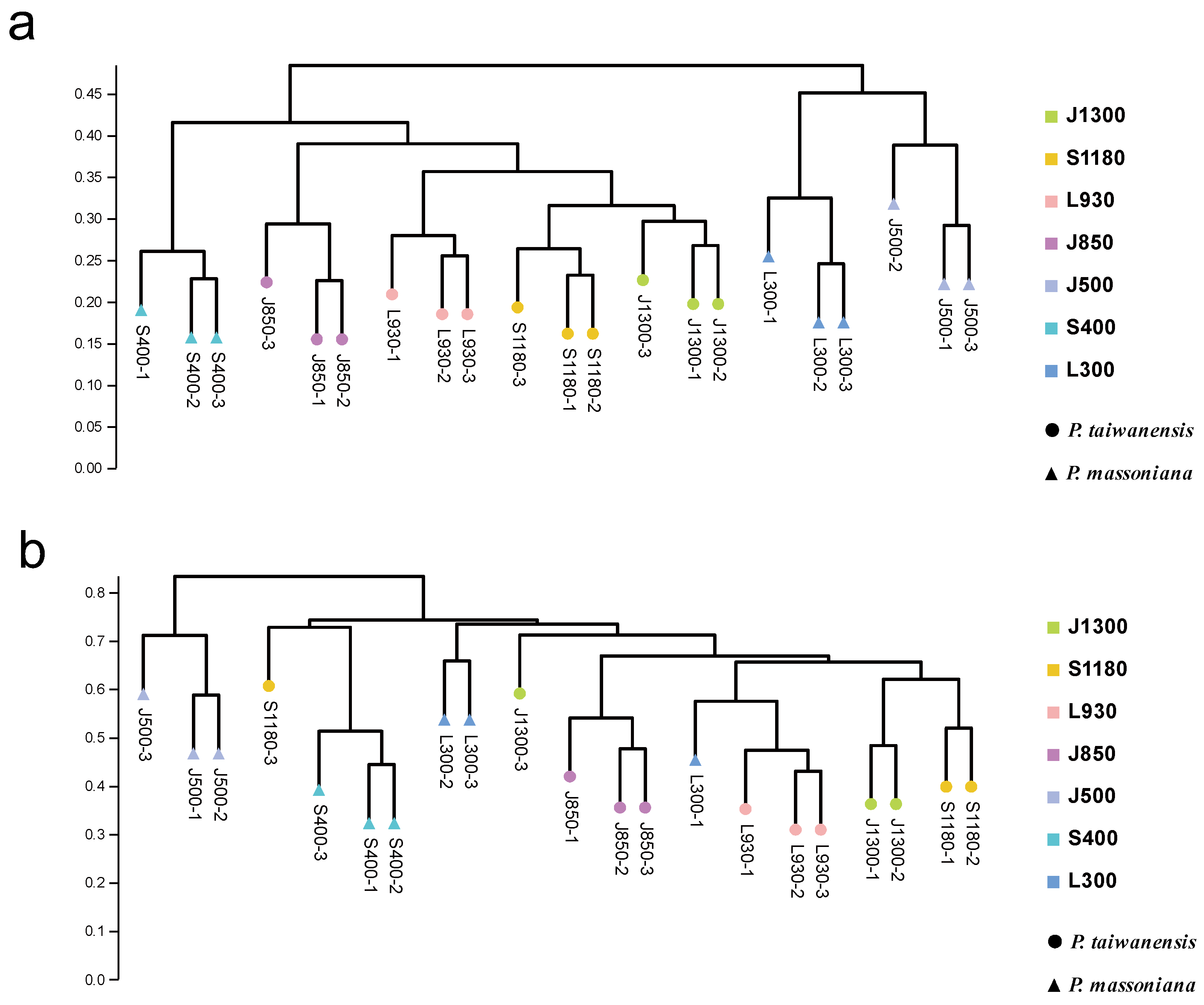

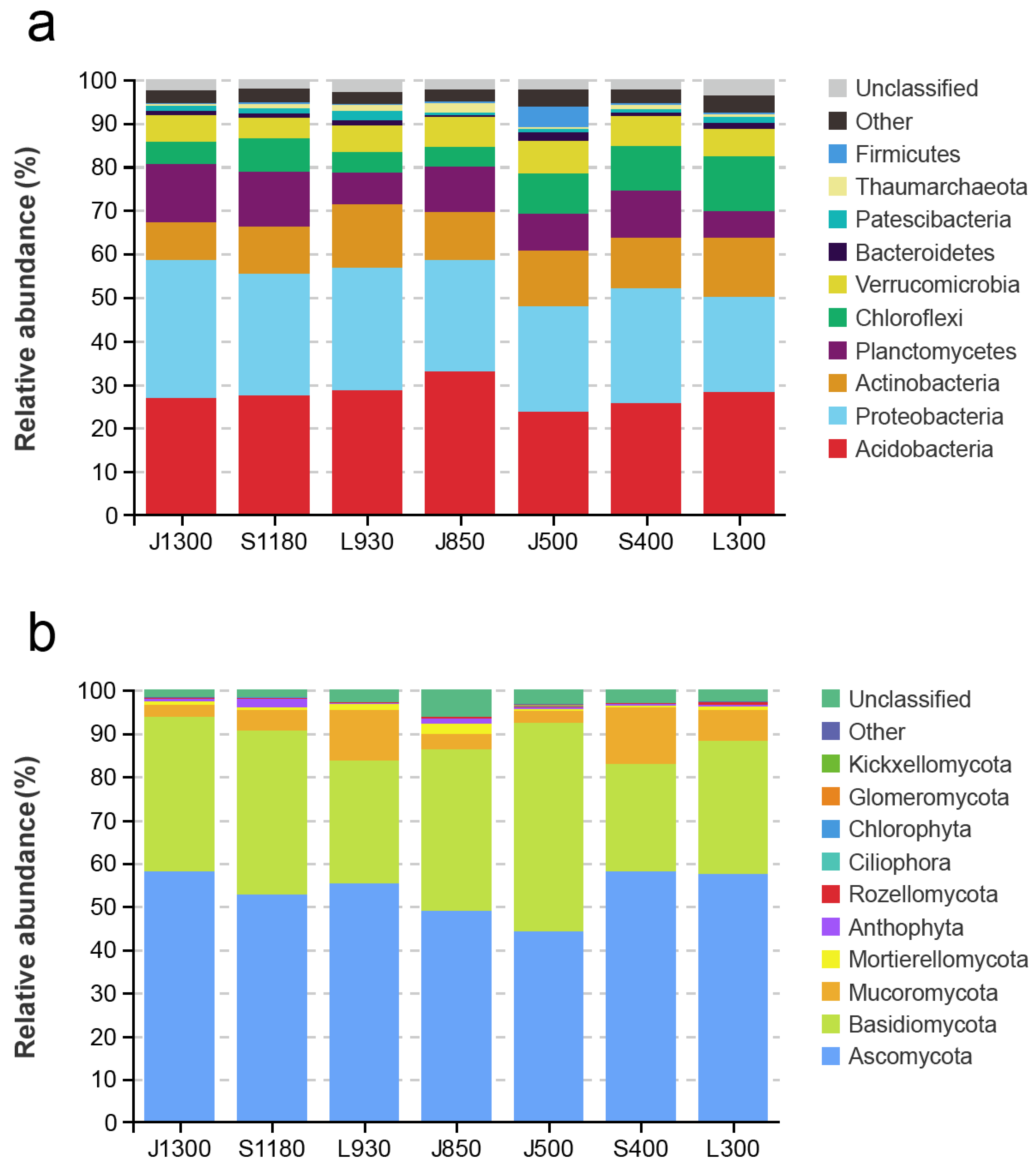
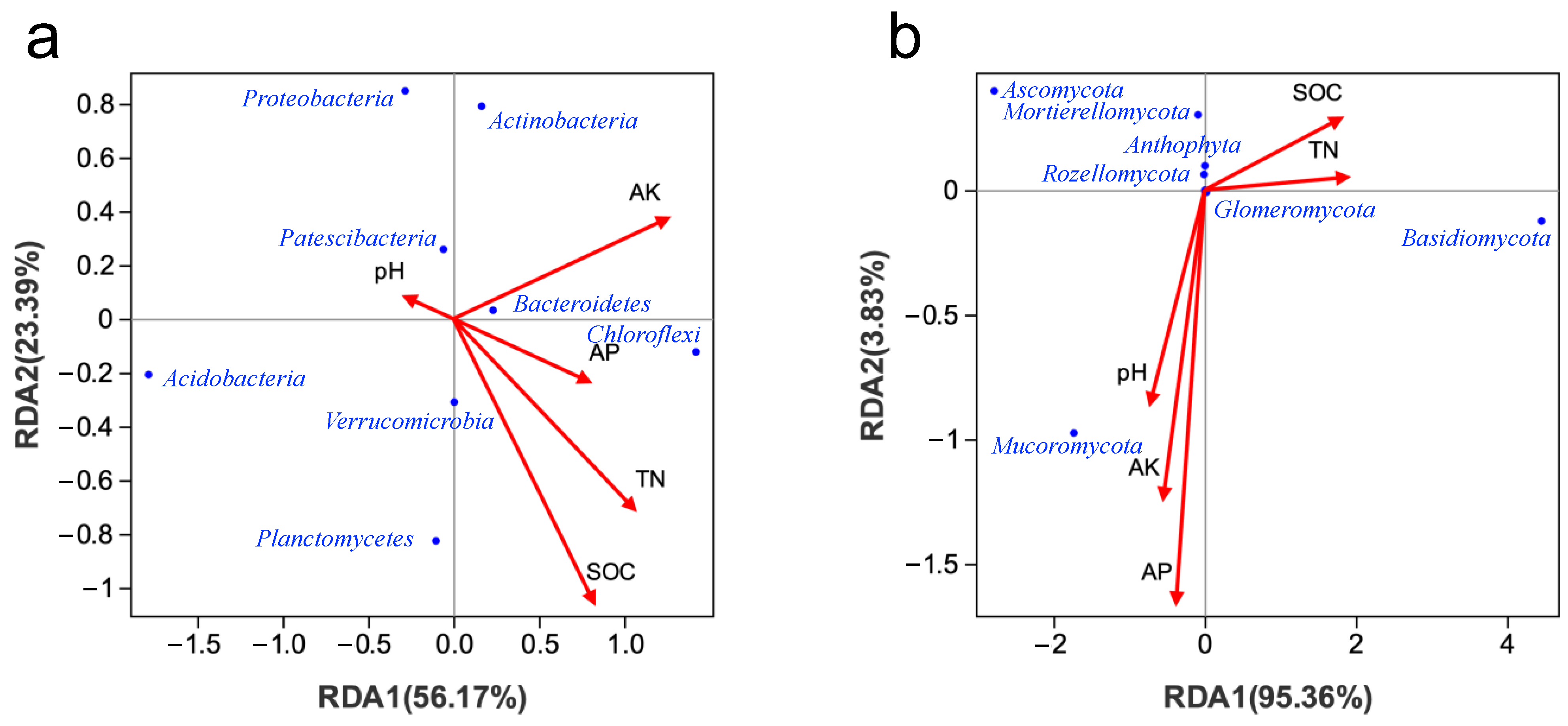
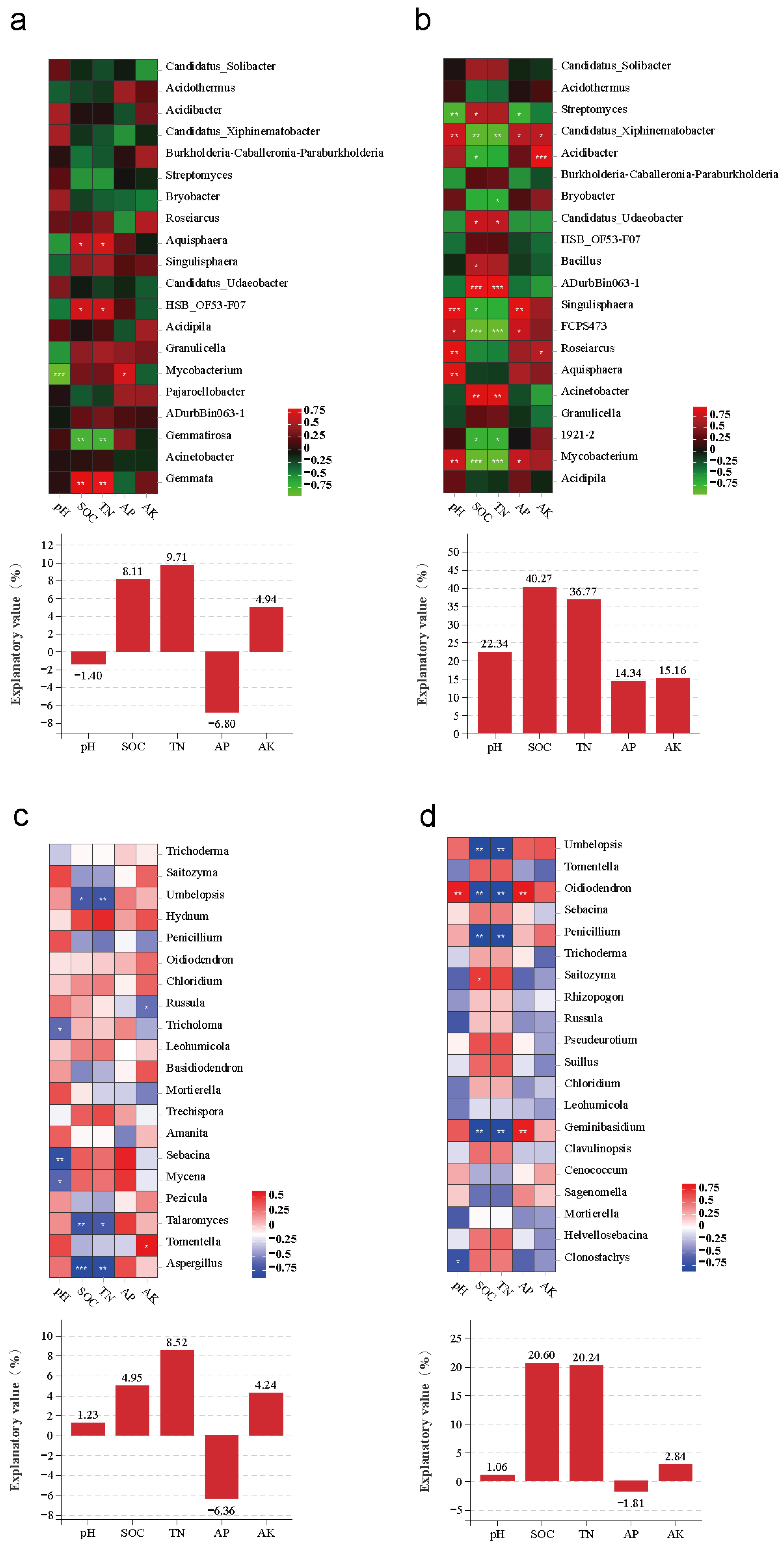
| Vegetation | Elevation (m) | pH | SOC (g/kg) | TN (g/kg) | AP (mg/kg) | AK (mg/kg) |
|---|---|---|---|---|---|---|
| Pinus taiwanensis | J1300 | 3.98 ± 0.03 b | 40.59 ± 3.45 b | 8.94 ± 0.73 b | 1.94 ± 0.06 bc | 72.16 ± 3.72 a |
| S1180 | 4.33 ± 0.03 a | 39.55 ± 4.85 b | 8.49 ± 0.87 b | 1.78 ± 0.26 c | 71.13 ± 6.04 a | |
| L930 | 4.25 ± 0.06 a | 61.83 ± 1.98 a | 13.06 ± 0.07 a | 2.62 ± 0.29 ab | 65.64 ± 3.96 a | |
| J850 | 3.81 ± 0.05 c | 41.97 ± 3.87 b | 8.54 ± 0.75 b | 3.29 ± 0.16 a | 43.3 ± 5.95 b | |
| Pinus massoniana | J500 | 4.63 ± 0.09 a | 16.74 ± 4.07 b | 4.52 ± 1.04 b | 3.94 ± 0.88 a | 104.81 ± 17.42 a |
| S400 | 4.31 ± 0.01 b | 37.99 ± 2.91 a | 7.41 ± 0.66 a | 1.68 ± 0.2 b | 37.11 ± 4.65 b | |
| L300 | 4.33 ± 0.03 b | 10.05 ± 3.65 b | 3.67 ± 0.63 b | 2.55 ± 0.45 ab | 58.08 ± 8.67 b |
| Variable | Bacterial Chao1 Index | Bacterial Shannon Index | Fungal Chao1 Index | Fungal Shannon Index | ||||
|---|---|---|---|---|---|---|---|---|
| r | p | r | p | r | p | r | p | |
| pH | −0.392 | 0.079 | −0.274 | 0.229 | 0.027 | 0.909 | 0.151 | 0.514 |
| SOC | 0.422 | 0.057 | 0.481 * | 0.027 | 0.043 | 0.854 | −0.178 | 0.44 |
| TN | 0.466 * | 0.033 | 0.531 * | 0.013 | 0.109 | 0.638 | −0.195 | 0.397 |
| AP | 0.399 | 0.073 | 0.337 | 0.136 | 0.378 | 0.091 | 0.268 | 0.241 |
| AK | −0.042 | 0.858 | 0.189 | 0.411 | 0.341 | 0.13 | −0.078 | 0.737 |
Disclaimer/Publisher’s Note: The statements, opinions and data contained in all publications are solely those of the individual author(s) and contributor(s) and not of MDPI and/or the editor(s). MDPI and/or the editor(s) disclaim responsibility for any injury to people or property resulting from any ideas, methods, instructions or products referred to in the content. |
© 2023 by the authors. Licensee MDPI, Basel, Switzerland. This article is an open access article distributed under the terms and conditions of the Creative Commons Attribution (CC BY) license (https://creativecommons.org/licenses/by/4.0/).
Share and Cite
Huang, K.; Xiang, J.; Ma, Y.; Cheng, J.; Gu, J.; Hu, M.; Yang, Y.; Fang, Y.; Wang, G.; Zhang, H. Response of Soil Microbial Communities to Elevation Gradient in Central Subtropical Pinus taiwanensis and Pinus massoniana Forests. Forests 2023, 14, 772. https://doi.org/10.3390/f14040772
Huang K, Xiang J, Ma Y, Cheng J, Gu J, Hu M, Yang Y, Fang Y, Wang G, Zhang H. Response of Soil Microbial Communities to Elevation Gradient in Central Subtropical Pinus taiwanensis and Pinus massoniana Forests. Forests. 2023; 14(4):772. https://doi.org/10.3390/f14040772
Chicago/Turabian StyleHuang, Kexin, Jian Xiang, Yuying Ma, Jinping Cheng, Jie Gu, Meng Hu, Yuan Yang, Yanming Fang, Genmei Wang, and Huanchao Zhang. 2023. "Response of Soil Microbial Communities to Elevation Gradient in Central Subtropical Pinus taiwanensis and Pinus massoniana Forests" Forests 14, no. 4: 772. https://doi.org/10.3390/f14040772
APA StyleHuang, K., Xiang, J., Ma, Y., Cheng, J., Gu, J., Hu, M., Yang, Y., Fang, Y., Wang, G., & Zhang, H. (2023). Response of Soil Microbial Communities to Elevation Gradient in Central Subtropical Pinus taiwanensis and Pinus massoniana Forests. Forests, 14(4), 772. https://doi.org/10.3390/f14040772







